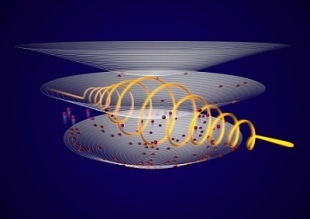Aug 19 2019
The “Landau-level laser” presents an interesting concept for an extraordinary radiation source. This kind of laser can efficiently produce what is known as terahertz waves.
 (Image credit: HZDR/Juniks)
(Image credit: HZDR/Juniks)
These radiations, in turn, can be utilized to penetrate materials and also for upcoming data transmission. However, to date, almost all attempts to achieve that kind of laser has been unsuccessful.
Now, an international research team has taken a significant step in the right direction: In Nature Photonics journal, the researchers have described a material that produces terahertz waves when an electric current is applied to it. At the German research center Helmholtz-Zentrum Dresden-Rossendorf (HZDR), physicists have contributed immensely to this latest project.
Similar to light, terahertz waves are electromagnetic radiation, with frequency ranges between infrared radiation and microwaves. The properties of the terahertz waves hold profound scientific and technological interest since they enable fundamental scientists to examine the propagation of spin waves or the oscillations of crystal lattices.
At the same time, “terahertz waves are of interest for technical applications because they can penetrate numerous substances that are otherwise opaque, such as clothing, plastics and paper,” explained Stephan Winnerl from HZDR’s Institute of Ion Beam Physics and Materials Research.
Today, terahertz scanners are already being used in airport security checks to detect whether passengers are hiding harmful objects under their clothing, without the need to use dangerous X-rays.
Since terahertz waves are known to have a higher frequency when compared to the radio waves used currently, they can also be harnessed for data transmission in the near future. For example, existing WLAN technology works at frequencies of 2–5 GHz.
Considering the fact that terahertz frequencies are approximately a thousand times higher, they can transmit music, video, and images more quickly, although across shorter distances. Conversely, the technology is yet to be fully developed.
There has been a lot of progress in recent years. But generating the waves is still a challenge—experts speak of a veritable terahertz gap.
Dr Stephan Winnerl, Institute of Ion Beam Physics and Materials Research, HZDR
One specific concern is the lack of a terahertz laser that is simulataneously strong, compact, and tunable.
Flexible Frequencies
The electrons in the laser material produce laser light. In accordance with the quantum effect, energized electrons generate light, but they can absorb only some portions and not just any haphazard amount of energy. Consequently, light is also produced in parts in a particular color and as a concentrated beam.
Of late, experts have focused their attention on a certain concept for a terahertz laser—the “Landau-level laser.” This laser is unique because it can utilize a magnetic field to flexibly tune the energy levels of electrons. These energy levels eventually establish the frequencies that are produced by the electrons, making the laser tunable—a major benefit for several technical and scientific applications.
However, there is one challenge: A laser like that is yet to become available.
“So far, the problem has been that the electrons pass their energy on to other electrons instead of emitting them as the desired light waves,” Winnerl explained.
This physical process is referred to as the “Auger effect” by experts. However, the experts were surprised to notice that this phenomenon also takes place in graphene—a material that is believed to be specifically promising for a “Landau-level laser.” In HZDR experiments, this two-dimensional (2D) form of carbon exhibited powerful Auger scattering.
A Question of Material
Hence, the researchers tested another material—a heavy metal alloy containing mercury, cadmium, and tellurium (HgCdTe). This alloy is utilized for very sensitive thermal imaging cameras, among other applications.
The unique trait of this material is that its tellurium, cadmium, and mercury contents can be selected quite accurately. This makes it possible to adjust a specific trait—band gap, a term coined by experts.
Consequently, the material displayed similar properties like graphene, but without the associated problem of strong Auger scattering.
There are subtle differences to graphene that avoid this scattering effect. Put simply, the electrons can’t find any other electrons that could absorb the right amount of energy.
Dr Stephan Winnerl, Institute of Ion Beam Physics and Materials Research, HZDR
Hence, the electrons have no option and are forced to get rid of their energy in the form preferred by the researchers—that is, terahertz radiation.
The study was an international team effort: the HgCdTe samples were prepared by Russian partners and these were later analyzed by the project’s group in Grenoble. One of the central analyses occurred in Dresden-Rossendorf—experts fired powerful terahertz pulses at the sample using the free-electron laser FELBE and were able to view the behavior of the electrons in temporal resolution.
The outcome: “We noticed that the Auger effect that we had observed in graphene had actually disappeared,” Winnerl reported happily.
LED for Terahertz
Finally, a research team in Montpellier noticed that when an electric current is applied to the HgCdTe compound, it actually produces terahertz waves. When the experts changed an additional magnetic field of just about 200 mT, they were able to alter the frequency of the generated waves in the 1–2 THz range—an adjustable radiation source.
It’s not quite a laser yet, but rather like a terahertz LED. But we should be able to extend the concept to a laser, even though it will take some effort.
Dr Stephan Winnerl, Institute of Ion Beam Physics and Materials Research, HZDR
That is what the French collaborators are planning to address next.
However, there is one restricting factor: Until now, the principle has only worked when cooled to extremely low temperatures, just above the absolute zero temperature.
“This is certainly a hindrance for everyday applications,” Winnerl summarized. “But for use in research and in certain high-tech systems, we should be able to make it work with this kind of cooling.”